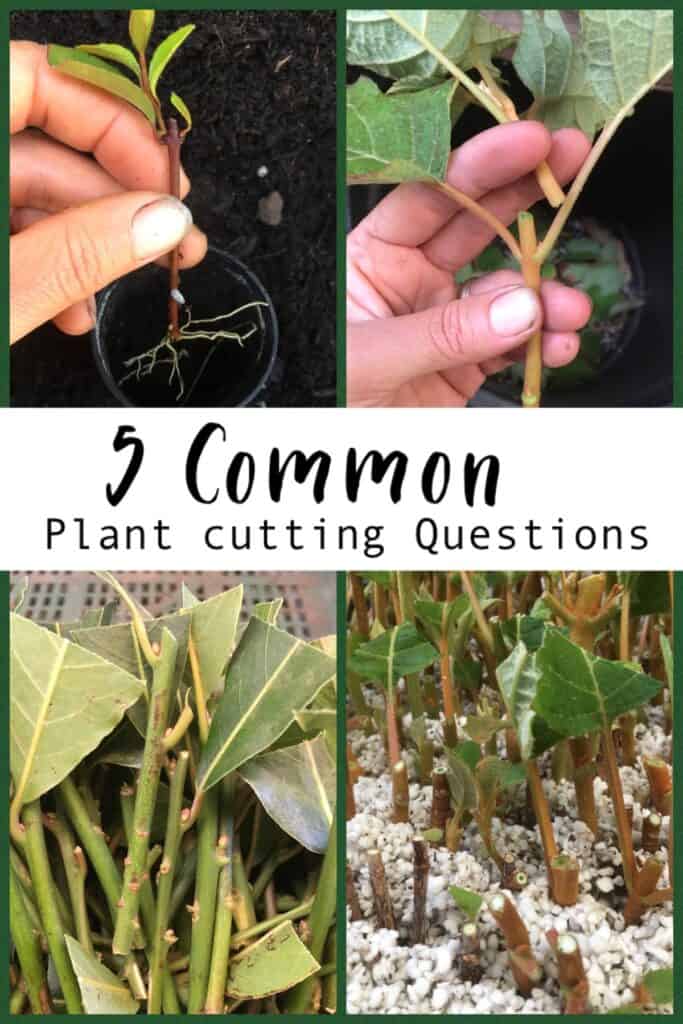
The 5 most common plant cutting questions we get asked
Petra and I have been working together in the nursery industry since the early 2000’s. Over that time lots of people have asked us about plant cuttings.
Cuttings are a very exciting form of propagation because your taking a piece of a plant with no roots, nothing to keep it alive essentially, and from this piece of plant you can create a whole new plant.
No wonder people are so curious to know how it’s done!
The questions we are answering here are:
- What’s the best time to take cuttings from plants?
- What propagation mix to use for cuttings?
- How long do cuttings take to root (strike)?
- Where should cuttings be kept?
- What plants can be grown by cuttings?
What’s the best time to take cuttings from plants?
The quick answer is, it varies from plant to plant. As well as the types of cuttings that are being used, however, there are some general rules we follow when taking cuttings.
Softwood cuttings
Most fast growing plants we would take softwood cuttings, and generally these softwood cuttings will strike roots fastest during their growing phase. This is generally during spring right through to early autumn. This is our preffered time to take cuttings, as they will produce a viable plant much faster then when the plant isn’t as active. Growing the plant quicker also reduces plant damage, from either pest or diseases.
It should be mentioned however that there are many fast growing perennials we personally take cuttings from even during the winter months. Brearing in mind that it will take longer for the cutting to root.
During the winter months we find watering cuttings can be challenging. In this time of cooler temperatures, the propagation mix can easily become too wet. If the mix is too wet the softwood cuttings easily rot or develop fungus issues.
If your determined to produce fast growing perennials during winter, so that they are ready for the spring, it’s worth investmenting in a heating mat. These are quite inexpensive and will greatly improve success rates for softwood cuttings taken during winter. The bottom heat created makes cuttings strike quicker, therefore minimising the chances of failure.
For a beginner, when taking fast growing softwood cuttings, stick to the warmer months of the year and you will find greater success.
Hardwood/Semi hardwood cuttings
Slower growing tree’s and shrub’s are often grown using hardwood or semi hardwood cuttings. These types of cuttings are much slower to strike roots, so the best time is during winter.
The cooler weather allows the plant longer to develop roots, without getting heat stressed.
For semi hardwood and hardwood, this time of year is our preferred choice in which to do cuttings of either, evergreen or deciduous. Evergreens can be taken right throughout the cooler months.
Deciduous plant cuttings we prefer to wait until the buds start to swell, usually a month after the shortest day of the year is a good time.
Summary
As you can see the timing depends on the type of plant cutting. There are cuttings that can be taken anytime and others that you need to be more aware when their best time is. We are in the process of adding plants we propagate to the site click here to find the list.
Below is a couple of videos. One showing hardwood cuttings of ligustrum undulatum- box leaf privet and the other showing softwood cuttings of Argyranthemum frutescens- single white daisy.
Example of hardwood cuttings
A short video showing how to propagate ligustrum undulatum- box leaf privet. These are a hardwood cutting.
Example of softwood cuttings
A short video on how to propagate Argyranthumum frutecens- single white daisy using softwood cuttings
What propagation mix to use for cuttings?
The most important requirement for a propagation mix is being able to hold moisture. Because the plant cuttings do not have a root system to support them, it’s critical that they are kept moist. It’s also important that the mix can breathe, this just means that oxygen is available.
Some plants can be propagated by placing cuttings into water and leaving them there until they take root. Whilst this can work very effectively for some plants others will quickly begin to rot.
My personal preference for a propagation mix is 90% perlite with 10% peat moss. We mix this up in large batches and use it for almost every plant we propagate using cuttings.
Occasionally we will also place cuttings directly into a potting or seed raising mix. We usually do this with plants that strike roots very fast, like cerastium tomentosum- snow in summer.
These are the only propagation mediums which we personally use, I’ll provide a brief summary of these and some other propagation media below.
Perlite
As i mentioned, perlite forms the base of my preferred cutting mix. Perlite is a natural forming volcanic rock or glass. The water retention capabilities are exceptional. Perlite has a neutral pH.
Whilst perlite holds moisture exceptionally it also holds it’s shape, which allows air to move through the mix. This allows the mix to breathe. Perlite also drains well, which helps reduce the risk of rot and fungus.
Perlite is completely sterile, which means you don’t need to be worried about unwanted pathogens or bacteria causing any damage.
Perlite is by far, my preferred mix for propagation.
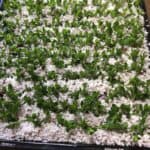
Cuttings in perlite peat moss mix
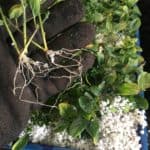
Cuttings with roots
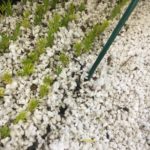
Diosma cuttings into perlite
Peat moss
Peat moss like perlite is exceptional at retaining moisture. Peat moss can hold 20X it’s weight in water. Peat moss contains beneficial micro organisms and small amounts of nutrients and minerals. Like perlite, peat moss is sterile, natural and free of unwanted pathogens.
As mentioned, we mix a small amount of peat moss into our perlite mix. This allows for greater water retention, provides a small amount of nutrients once roots develop and adds beneficial micro organisms.
Peat moss has a few disadvantages that prevent it from being used in it’s own right. Peat moss holds moisture too well and can easily become water logged. It’s also slightly acidic in pH which can be problematic for plants that prefer more alkaline conditions.
By adding just 10% to our perlite, the above disadvantages are neutralised, whilst allowing the benefits.
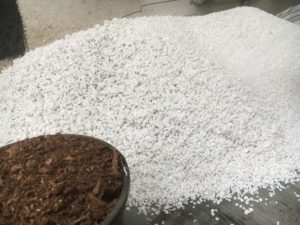
Quick tips for mixing perlite/peat moss propagation mix
- Water the perlite before you start mixing (the fine dust can irritate eyes and breathing).
- Wear a mask or put a wet cloth over your mouth and nose.
- Mix on a clean sterile surface.
- Massage the clumps of peat moss into the perlite getting, it as fine as you can.
- Place mix in a seedling tray, lightly water and store until needed.
Water
A glass of water with some cuttings on a sunny windowsill can be a great way to produce free plants. It’s very easy to do. So long as you select the appropriate plants to propagate in water. We have had success recently with hoya- wax plant cuttings placed in a glass of water. Many common garden herbs will also be suitable.
I recommend you change the water every now and then to replenish the oxygen levels in the water. The success rate was around 75% on these hoya cuttings, not too bad!
A disadvantage to water propagation is that the shock to the plant when you place it into potting mix can cause a few extra losses. Water propagation is certainly worth a try.
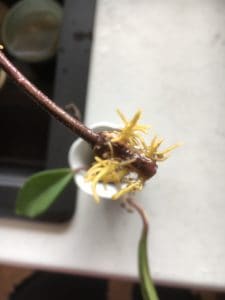
Hoya struck roots in water
Vermiculite
Vermiculite is very similar to perlite, it is also naturally formed and has a neutral pH. Vermiculite is sterile, inorganic and will not rot.
Vermiculite can hold more moisture than perlite, but is not as well draining. Also it compacts easier leading to less aeration.
Vermiculite can be a good choice for cutting propagation, I just find that it can be too easy to overwater because it doesn’t drain as freely as perlite. Overwatering cuttings can quickly lead to rot.
Vermiculite would be a great choice along with peat moss for more water loving plants.
Coarse sand
Another popular propagation medium is coarse sand. It’s natural, free draining and inexpensive. Coarse sand also allows for good aeration.
Sand drains very freely, so it’s a must that it be mixed with other propagation mediums such as vermiculite or peat moss, to help retain some moisture. Whilst this is not a medium we use, if you were to use coarse sand, I would mix 50% coarse sand with 50% peat moss or vermiculite. Possibly even a mix of both in with the sand.
Another worry I have with using sand is bringing in unwanted pathogens. I’m sure this is not a problem for sand brought specifically for propagation and packaged appropriately, but more for sand collected from the great outdoors.
I would say that coarse sand would provide an ideal propagation medium for cacti and succulent cuttings.
Potting/seed raising mix
There are many different potting and seed raising mixes available on the market. Almost all are guaranteed to have one or more of the above propagation media included in the mix.
There are a few advantages to a potting or seed raising mix. Because they will generally contain some elements of compost, there should also be nutrients available for the plants. This is not important when the plant is a cutting as it has no roots to take up the nutrients, but once the roots develop and the cutting begins to grow, it will need nutrients.
Potting/seed raising mixes can allow a cutting to be placed directly into a pot, removing the actual striking component of the cutting phase, elimenating double handling. Whilst the cuttings we strike in our perlite/peat moss mix or any of the other mentioned media, need to be potted up into potting mix once the root system has developed.
The disadvantages are that, these mixes are not a sterile and may contain unwanted pathogens, chemicals or weed seeds. It is also only suitable for select plant varieties.
Propagation Kit
We put together a resource page that contains links to the products we use or similar. If you want to check that out click the link.
How long do cuttings take to root (strike)?
Again, just like the best time to take cuttings question, this is not a one size fits all answer. We can however make some educated observations;
Slower growing plants take longer to develop roots, than faster growing plants.
Harwood cuttings will take longer to root than softwood cuttings.
Some plants can develop a root system in as little as a month, whilst we’ve propagated others that have been in our propagation mix for 12 months before an adequate root system has developed.
The time of year will also impact the timeframe for the cuttings to strike roots. Provided moisture can be kept up to the cuttings, roots will develop much faster during summer. It’s not so much the temperature of the air but more the temperature of the propagation mix.
Applying heat to the propagation mix at a steady rate will greatly improve the time taken to strike cuttings. There are many heat mats available online. We rarely use our heating mats, but if we do, we set them on a steady 20C (68F).
Under optimal conditions we expect most plants to develop roots within 2-3 months.
Below are some examples of differing timeframes in which roots can develop.
Example of a fast striking cutting
These Erigeron-Seaside daisy cuttings took 8 weeks to develop a strong root system in a perlite/peat moss mix. The cuttings were taken in autumn and no heating was applied. If these were taken in summer the timeframe would be around 6 weeks.
Example of a slower striking cutting
These Coleonema Pulchrum Aurea- Golden diosma were taken at the beginning of summer and took about 3 months too develop a good root system. Had these been taken during a cooler time of year the time frame would stretch out to 5 or even 6 months.
Where should cuttings be kept?
This question is not as commonly asked as the other questions, but it’s one of the most important aspects of successful cutting propagation.
A cutting must have adequate moisture as we have discussed, it also needs light for photosynthesis and it needs protection from elements that will dry it out.
Light
Plants need light to survive and a cutting is no different, the light source can be from the sun or from an artificial source. Direct sunlight is no good for growing cuttings as it’s too intense and will dry the cutting out (as it has no roots).
Filtered light is fine. For example, it’s common here in Australia for us to strike cuttings on our north facing window sills indoors. In the northern hemisphere the southern side will have more light.
We grow most of our cuttings in our greenhouse which has a protective film, and a 30% shade cloth. Here in Australia the sun can be quite intense. The film and the shade cloth reduce the strength of the light but still allow an adequate amount in.
So just make sure that the cuttings receive an adequate amount of filtered light.
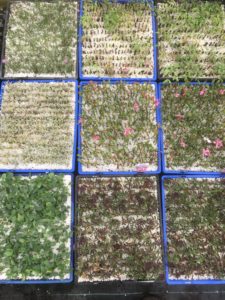
Plant cuttings in our greenhouse
Wind & temperature extremes
The other requirements that plant cuttings must have is protection from the elements. Once plants are established they are very tough and adaptable. But as a cutting they are weak and fragile, and need our help.
Sheltering from the wind is critical! Wind will dry a cutting out super fast, it won’t matter how good the mix is or how often you water. Wind saps moisture and as we’ve established, the cuttings must have a constant supply of moisture to make up for their lack of roots.
Another problem is temperature extremes. For example extreme heat will wilt and dry out your cuttings, whilst extreme cold produces frosts which also pull moisture from the cuttings. In both of these circumstances, the cuttings will need your help to protect them.
This is why commercial growers use greenhouses/ glass houses. It protects the cuttings from the elements and provides a very stable controlled environment.
For the home gardener
As I mentioned a great place for storing cuttings is a well lit indoor window sill. This will provide adequate light, protection from the elements and a stable temperature. Not to mention that you’ll see them everyday and are less likely to forget about them!
When we started our nursery we didn’t have a green house, I cordoned off a small area of our verandah (patio). It was under cover so was protected from direct sunlight. I then enclosed the exposed railing so that they were sheltered from the wind. Being under cover it was also protected from frosts.
Building a cold frame for those that are really keen, would be of great benefit. They are simple to construct and will help you give your plants the best start possible. Very useful for getting those first veggie and perennial crops ready for spring planting. Just remember to check on you cuttings and water them!
There are lots of propagation kits available on the market some even include heat mats. Most of these kits are quite small and i wouldn’t use them outside. Because they are so small I would still be worried about extremes of cold or heat. Keep them inside and monitor regularly.
If you want to get serious build a small green house or glass house structure. A few old windows and a simple frame and roof can provide an awesome potting shed/green house for cutting propagation.
Otherwise if you can buy a small hoop greenhouse or a nice looking glass house. These are becoming more affordable all the time. These are also great for growing vegetables:)
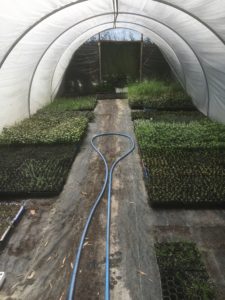
Inside our small green house
Whatever you choice ,as long as you provide moisture, light and protection you’ll be on the road to propagation success.
Which plants can be grown by cuttings?
Well thousands, i’m by no means an expert but i’m going to try and write a list of plants that i’ve researched and found to be viable candidates for propagating via cuttings.
Over time as the plants we propagate in our nursery and as our web site grows, we will endevour to provide detailed notes on propagating some of these plants.
Of course, some plants we will be unable to cover, due to climate restrictions or just plain lack of skill, but we will do our best! Be sure to subscribe to help us provide this content 🙂
I’m going to break this list down into categories: Trees and shrubs, Annuals/Perennials, Vegetables/Herbs, Creepers & Climbers.
I’m leaving off succulents and cacti as I they are not something we grow very often as we are in a high rainfall area, there is also loads of information on propagation by cuttings of succulents and cacti available online.
I’m also leaving off most fruiting trees as these are more commonly grafted onto strong root stock.
I will not include any Orchids, Palms, Cycads and Ferns as these are propagated using seed or division. Also there will be no grasses, sedges or proper bamboo’s on this list, more often than not these are propagated by seed or division.
Tree’s and Shrubs which can be propagated by cuttings.
- Abelia
- Abies (Fir trees)
- Abutilon (Chinese lantern)
- Acacia (Wattle)
- Acalypha
- Acca (Feijoa)
- Acer (Maple)
- Acmena (Lily Pilly)
- Agonis (Peppermint tree, Willow myrtle)
- Alyogyne (Blue hibiscus)
- Arbutus (Strawberry tree)
- Argyranthemum (Magurerite daisy)
- Argyrocytisus (Silver broom)
- Aronia (Chokeberry)
- Atriplex (Salt bush)
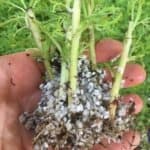
Argyranthemum, struck cuttings
- Baccharis (Broom)
- Backhousia (Lemon scented myrtle)
- Barleria
- Bartlettina
- Bauhinia
- Berberis (Barberry)
- Betula(Birch)
- Bixa (lipstick plant)
- Boronia
- Brachychiton
- Brachyglottis
- Breynia
- Broussonetia
- Brugmansia
- Brunfelsia
- Buddleja
- Burchellia
- Buxus (Box)
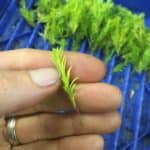
Golden diosma cutting
- Calliandra
- Callicarpa (Beauty bush)
- Callistemon (Bottle brush)
- Calluna
- Calocedrus
- Calothamnus (Claw flower or Net bush)
- Camellia
- Cantua
- Caragana (Pea shrub or pea tree)
- Carica
- Carissa
- Carmichaelia
- Caryopteris
- Cassia
- Cassiope
- Catalpa
- Ceanothus (Californian lilac)
- Ceiba
- Cephalotaxus (plum yew)
- Cercidiphyllum
- Cercis
- Cestrum
- Chaenomeles (Flowering Quince)
- Chamaecyparis
- Chamaecytisus
- Chamelaucium (Geralton wax)
- Chilopsis
- Chimonanthus
- Choisya
- Chorizema
- Cinnamomum(Cinnamon)
- Cistus
- Cladrastis
- Clerodendrum (Glory bower)
- Clethra
- Clianthus
- Clusia
- Coccoloba
- Codiaeum
- Coleonema (Diosma)
- Colletia (Anchor plant)
- Colutea
- Combretum
- Coprosma (Mirror bush)
- Cordia
- Cordyline (Cabbage tree)
- Cornus (Dog wood)
- Corokia
- Correa
- Corylopsis
- Cotinus (Smoke bush)
- Cotoneaster
- Crescentia
- Cryptomeria
- Cunninghamia
- Cunonia
- Cuphea
- Cupressus (Cypress)
- Cytisus (Broom)
- Daboecia
- Dacrydium
- Dais
- Daphne
- Darwinia
- Delonix
- Dendromecon
- Desfontainia
- Deutzia
- Dillenia
- Disanthus
- Dodonaea (Hop bush)
- Dombeya
- Dracaena
- Drimys
- Duranta
- Edgeworthia
- Elaeagnus
- Elaeocarpus
- Embothrium
- Empetrum
- Enkianthus
- Epacris
- Epigaea
- Eranthemum
- Eremophila
- Erica (Heath or Heather)
- Eriostemon
- Erythrina (Coral tree0
- Escallonia
- Eugenia (Stopper)
- Euonymus
- Euphorbia
- Euryops
- Exochorda (Pearl bush)
- Fabiana
- Fatsia
- Ficus (Fig)
- Firmiana
- Forsythia
- Fothergilla
- Fremontodendron (Flannel bush)
- Fuchia
- Garcinia
- Gardenia
- Garrya
- Gaultheria
- Genista
- Ginkgo
- Glyptostrobus
- Gordonia
- Graptophyllum
- Grevillea
- Grewia
- Greyia
- Griselinia
- Halesia (Silverbell)
- Halimium
- Halleria
- Hebe
- Helianthemum (Rock rose or sun rose)
- Heptacodium
- Heteromeles (California holly)
- Hibbertia (Golden Guinea flower)
- Hibiscus
- Hoheria (Lacebark or Ribbonwood)
- Holmskioldia
- Hydrangea
- Hymenosporum
- Hypericum
- Hypoestes
- Idesia (Wonder tree)
- Ilex (Holly)
- Illicium (Anise)
- Indigofera
- Iochroma
- Isopogon
- Itea (Sweetspire)
- Ixora (Jungle flame)
- Jacaranda
- Jasminum (Jasmine)
- Jatropha
- Juniperus (Juniper)
- Justicia
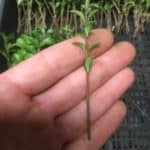
Ligustrum undulatum- box leaf privet cutting
- Kalmia (Laural)
- Kalopanax
- Kerria
- Koelreuteria
- Kolkwitzia (Beauty bush)
- Kunzea
- Lagerstroemia (Crape Myrtle)
- Lantana
- Lavendula (Lavender)
- Lavatera (Tree Mallow)
- Leptospermum (Tea-Tree)
- Leschenaultia
- Leucadendron
- Leucaena
- Leucophyta (Cushion Bush)
- Leucospermum (Pincushion)
- Leucothoe
- Leycesteria
- Ligustrum (Privet)
- Lindera
- Liquidambar (Sweet Gum)
- Lithodora
- Lomatia
- Lonicera (Honey Suckle)
- Lophomyrtus
- Loropetalum (Fringe flower)
- Luculia
- Luma
- Mackaya
- Maclura
- Magnolia
- Mahonia
- Malpighia
- Malvaviscus
- Maytenus
- Megaskepasma
- Melaleuca
- Melastoma
- Melianthus
- Metrosideros
- Michelia
- Microbiota (Russian Cypress)
- Mimosa
- Montanoa
- Morella (Waxberry)
- Murraya
- Mussaenda
- Myoporum (Boobialla)
- Myrtus (Myrtle)
- Nageia
- Nandina (Heavenly Bamboo or Sacred bamboo)
- Neillia
- Nerium (Oleander)
- Nothofagus (Southern Beech)
- Nyssa
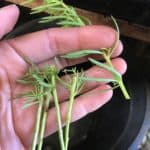
Myoporum cuttings
- Ochna
- Olea (Olive)
- Oleria
- Oplopanax
- Orphium
- Osmanthus
- Oxydendrum (Sorrel tree or Sourwood)
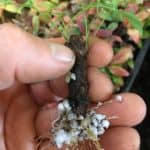
Nandina cuttings
- Pachira
- Pachystachys
- Parmentiera
- Parrotia (Iron Tree)
- Paulownia
- Pavonia
- Phellodendron
- Philadelphus (Mock Orange)
- Photinia
- Phygelius
- Phylica
- Physocarpus
- Phytolacca
- Picea (Spruce)
- Pieris
- Pimelea
- Pistacia (Pistachio)
- Pittosporum
- Platanus (Plane Tree)
- Platycladus
- Plumbago (Leadwort)
- Plumeria
- Podalyria
- Podocarpus
- Polyalthia
- Polygala
- Polyscias
- Populus (Poplar or Aspen)
- Prinsepia
- Prosopis
- Prostanthera
- Protea
- Prunus
- Pseuderanthemum
- Pseudopanax
- Psidium
- Psoralea
- Pterocarya
- Pterostyrax
- Pycnostachys
- Pyracantha (Firethorn)
- Quillaja
- Radermachera
- Rehderodendron
- Reinwardtia
- Retama
- Rhamnus
- Rhaphiolepis
- Rhododendron (Azalea)
- Rhodoleia
- Rhus (Sumac)
- Ribes (Currant)
- Ricinocarpos
- Robinia
- Roella
- Roldana
- Rondeletia
- Rosa(Rose)
- Rothmannia
- Rubus
- Ruspolia
- Russelia
- Ruttya
- Salix (Willow)
- Salvia (Sage)
- Sambucus (Elder)
- Sanchezia
- Santolina
- Sapindus
- Sarcococca (Sweet box or christmas box)
- Sassafras
- Schefflera
- Schima
- Schinus
- Schotia
- Senna (Cassia)
- Sequoia (Redwood)
- Sequoiadendron (Big tree, Giant Sequoia or Sierra redwood)
- Sesbania
- Shepherdia (Buffalo berry)
- Skimmia
- Solanum
- Sophora
- Sorbaria
- Sparmannia (African hemp or house lime)
- Spartium
- Spiraea (Bridal wreath)
- Stachyurus
- Staphylea (Bladdernut)
- Stewartia
- Streptosolen
- Strychnos
- Styrax
- Sutherlandia (Balloon Pea)
- Swietenia (Mahogany)
- Symphoricarpos (Snowberry or Coralberry)
- Symplocos
- Syringa (Lilac)
- Tabebuia (Golden trumpet tree)
- Tabernaemontana
- Tamarindus
- Tamarix
- Taxus (Yew)
- Tecoma
- Telopea (Waratah)
- Ternstroemia
- Tetraclinis
- Tetradenia
- Tetradium
- Tetratheca
- Thevetia
- Thryptomene
- Thuja (Arborvitae)
- Thujopsis
- Tibouchina (Glory bush)
- Tilia (Basswood or Linden)
- Torreya (Nutmeg)
- Toxicodendron (Poison oak)
- Trevesia
- Triadica
- Tristania
- Trochodendron
- Tsuga (Hemlock)
- Umbellularia (California laurel)
- Verticordia
- Vestia
- Viburnum
- Vitex
- Weigela (Cardinal bush)
- Weinmannia
- Westringia (Native rosemary)
- Widdringtonia
- Wigandia
- Xanthoceras
- Zanthoxylum
- Zelkova
- Zenobia
- Ziziphus
Annuals/Perennials that can be grown by cuttings
- Abelmoschus
- Acanthus (Bears breeches or Oyster plant)
- Aethionema (Stone cress)
- Agastache (Hyssop)
- Ageratum (Floss flower)
- Aglaonema
- Ajuga (Bugle)
- Alocasia
- Alstroemeria
- Alteranthera
- Amsonia (Blue star)
- Anagallis (Pimpernel)
- Anaphalis (Pearly everlasting)
- Androsace (Rock jasmine)
- Anemone (Windflower)
- Angelonia
- Anthemis (Dog fennel)
- Antirrhinum (Snapdragon)
- Arabis (Rock cress)
- Arctotis (African Daisy)
- Arenaria (Sandwort)
- Ameria (Thrift)
- Artemisia
- Asclepias (Milkweed)
- Asperula (Woodruff)
- Aster
- Aubrieta
- Aurinia
- Ballota
- Bassia
- Begonia
- Brachyscome (Rock daisy)
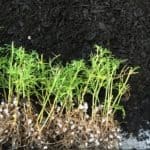
Brachyscome cuttings
- Calamintha (Calamint)
- Calceolaria
- Calibrachoa
- Campanula
- Catharanthus
- Centaurea (Cornflower)
- Cephalotus
- Cerastium
- Chrysanthemum
- Columnea
- Convolvulus (Silver bush)
- Convolvulus Sabatius
- Coreopsis (Tickseed)
- Cosmos (Mexican aster)
- Costus
- Ctenanthe
- Cynoglossum (Hounds tongue)
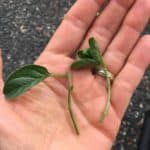
Convolvulus sabatius, cuttings
- Delphinium
- Derwentia
- Dianthus (Carnation)
- Diascia (Twinspur)
- Dicentra (Bleeding heart)
- Dichorisandra
- Dicliptera
- Dieffenbachia (Mother-in-laws tongue)
- Dimorphotheca
- Drosera (Sundew)
- Dryas (Mountain avens)
- Echium
- Edmondia
- Elodea
- Epilobium (Willow herb)
- Episcia
- Erigeron
- Eriogonum (Wild buckwheat)
- Erodium (Storksbill)
- Erysimum (Wallflower)
- Eupatorium
- Euphorbia
- Eustoma
- Evolvulus
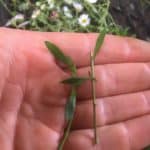
Erigeron cuttings
- Felicia
- Gaillardia
- Gaura
- Gazania (Treasure flower)
- Genlisea
- Geranium
- Gloxinia
- Gynura (Velvet plant)
- Gypsophila (Baby’s breath)
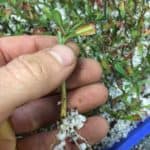
Gaura cuttings
- Helenium (Sneezeweed)
- Helianthus (Sunflower)
- Helichrysum
- Heliotropium
- Hemigraphis
- Iberis (Candytuft)
- Impatiens
- Iresine (Bloodleaf)
- Ismelia
- Lamium (Dead-nettle)
- Leonotis
- Lespedeza
- Leucanthemum
- Limonium (Statice)
- Lobelia
- Lotus
- Ludwigia (Primrose)
- Lychnis (Catchfly)
- Lysimachia (Loosestrife, creeping jenny or moneywort)
- Malcolmia (Virginia stock)
- Malva (Musk mellow)
- Maranta (Prayer plant)
- Mazus
- Mimulus (Monkey flower)
- Minuartia (Sandwort)
- Moltkia
- Monarda (Bee balm)
- Nepenthes (Pitcher plant)
- Nepeta (Catmint or catnip)
- Nicotiana (Tobacco)
- Nierembergia (Cupflower)
- Oenothera (Evening primrose)
- Orthosiphon
- Osteospermum (African Daisy)
- Otacanthus
- Pachysandra (Spurge)
- Papaver (poppy)
- Parahebe
- Pelargonium (Geranium)
- Penstemon
- Pentas
- Peperomia
- Pericallis (Cineria)
- Perovskia
- Persicaria (Knotweed)
- Petunia
- Phlomis
- Phlox
- Physalis
- Pilea
- Pinguicula (Butterwort)
- Plectranthus
- Potamogeton (Pondweed)
- Pulmonaria (Lungwort)
- Ramonda
- Rehmannia (Chinese foxglove)
- Rhodanthe (Strawflower)
- Rhodanthemum
- Romneya
- Rudbeckia (Black-eyed Susan or cone flower)
- Ruellia
- Rumex
- Saintpaulia (African violet)
- Saponaria (Soapwort)
- Scabiosa (Scabious)
- Scaevola
- Schaueria
- Scleranthus
- Scrophularia (Figwort)
- Sedum
- Serissa
- Shortia
- Silene (Campion)
- Solenostemon
- Solidago (Goldenrod)
- Stachys (Lamb’s ear)
- Streptocarpus (Cape primrose)
- Strobilanthus
- Stromanthe
- Stylidium
- Sutera
- Swainsona (Desert pea)
- Teucrium (Germander)
- Tithonia (Mexican sunflower)
- Townsendia
- Trachelium
- Tradescantia (Spiderlily or spiderwort)
- Trichostema
- Valeriana (Valerian)
- Verbena
- Veronica
- Viola
- Zaluzianskya
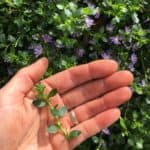
Cutting, Scaevola albida
Vegetables and Herbs which can be grown by cuttings.
- Aloysia (Lemon scented verbena)
- Bergera (Curry tree)
- Glycine (Soybean)
- Hyssopus (Hyssop)
- Laurus (Bay leaf)
- Lycium (Goji)
- Melissa (Lemon balm)
- Mentha (Mint)
- Nepeta (Catmint)
- Oenanthe (Water celery)
- Origanum (Marjoram)
- Rorippa (Watercress)
- Rosmarinus (Rosmary)
- Ruta(Rue)
- Salvia(sage)
- Satureja (Savory)
- Sechium (Chaco)
- Thymus(Thyme)
- Urtica (Nettle)
Climbers and Creepers which can be propagated by cuttings.
- Aeschynanthus (Basket plant)
- Akebia
- Ampelopsis
- Antigonon
- Aristolochia (Dutchman’s pipe)
- Beaumontia
- Berberidopsis
- Bougainvillea
- Campsis (Trumpet vine)
- Celastrus (Bittersweet)
- Cissus
- Clematis (Leather vine)
- Clytostoma
- Cobaea
- Congea
- Distictis
- Eccremocarpus (Chilean glory flower)
- Epipremnum
- Fallopia (Knotweed)
- Ficus (Climbing fig)
- Gelsemium (Carolina jasmine)
- Hardenbergia
- Hedera (Ivy)
- Hoya
- Humulus
- Ipomoea
- Jasminum (Jasmine)
- Lonicera (Honeysuckle)
- Mandevilla
- Muehlenbeckia (Wire vine)
- Pandorea
- Parthenocissus (Boston ivy)
- Passiflora (Passionfruit)
- Petrea (Blue bird vine)
- Philodendron
- Podranea
- Pyrostegia
- Quisqualis
- Saritaea
- Schisandra
- Schizophragma
- Senicio
- Solandra (Chalice vine)
- Sollya
- Strongylodon
- Strophanthus
- Tecomanthe
- Thunbergia
- Tracelospermum (Star jasmine)
- Tropaeolum (Nasturtium)
- Tweedia
- Wisteria
